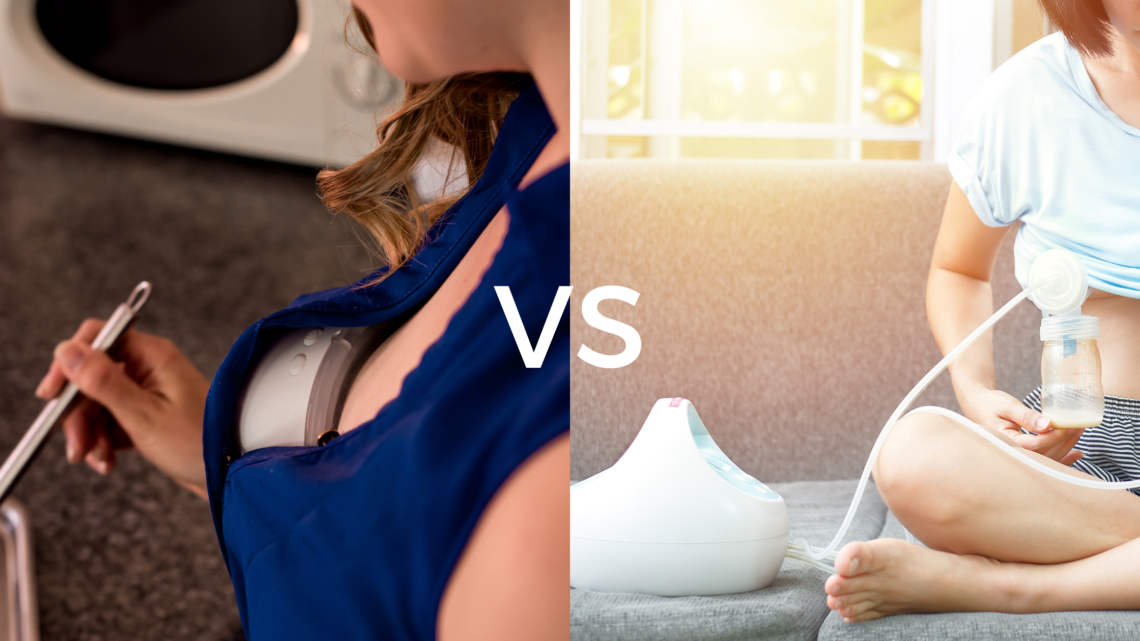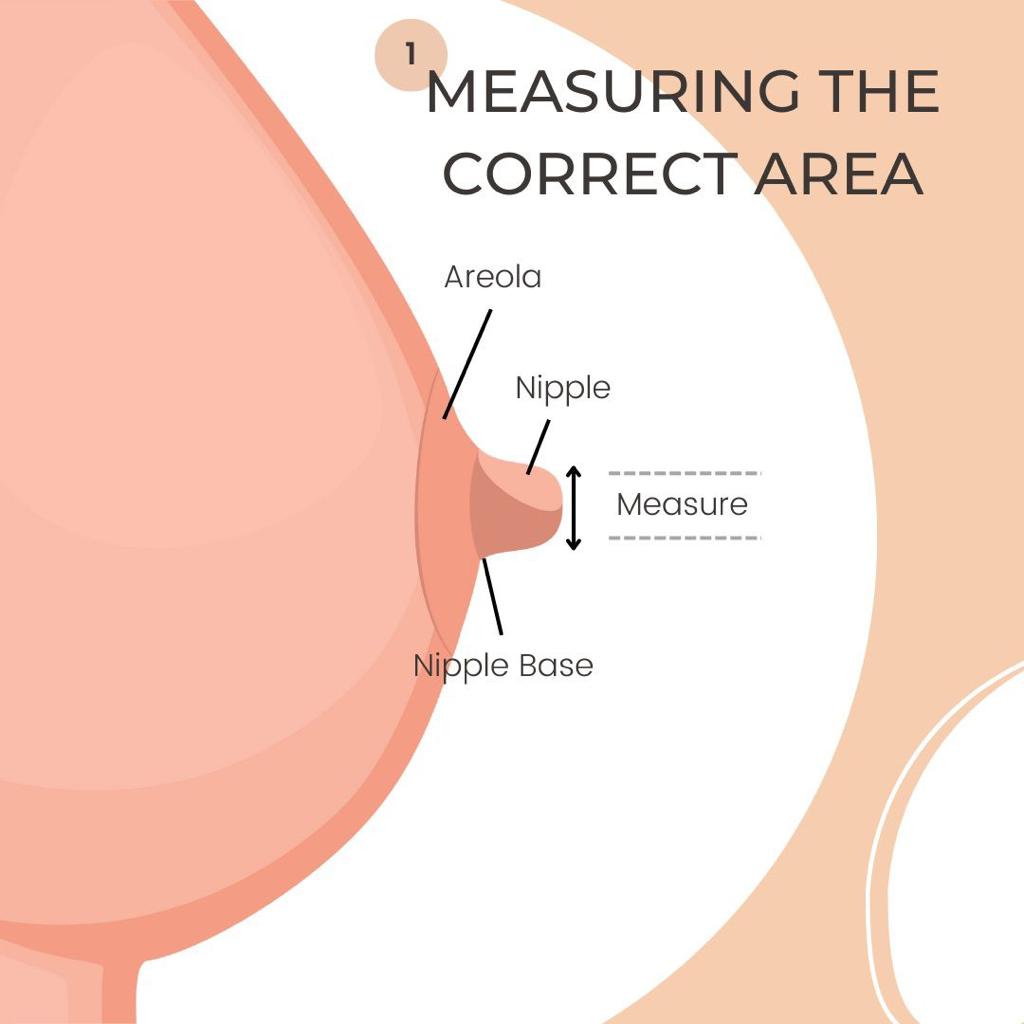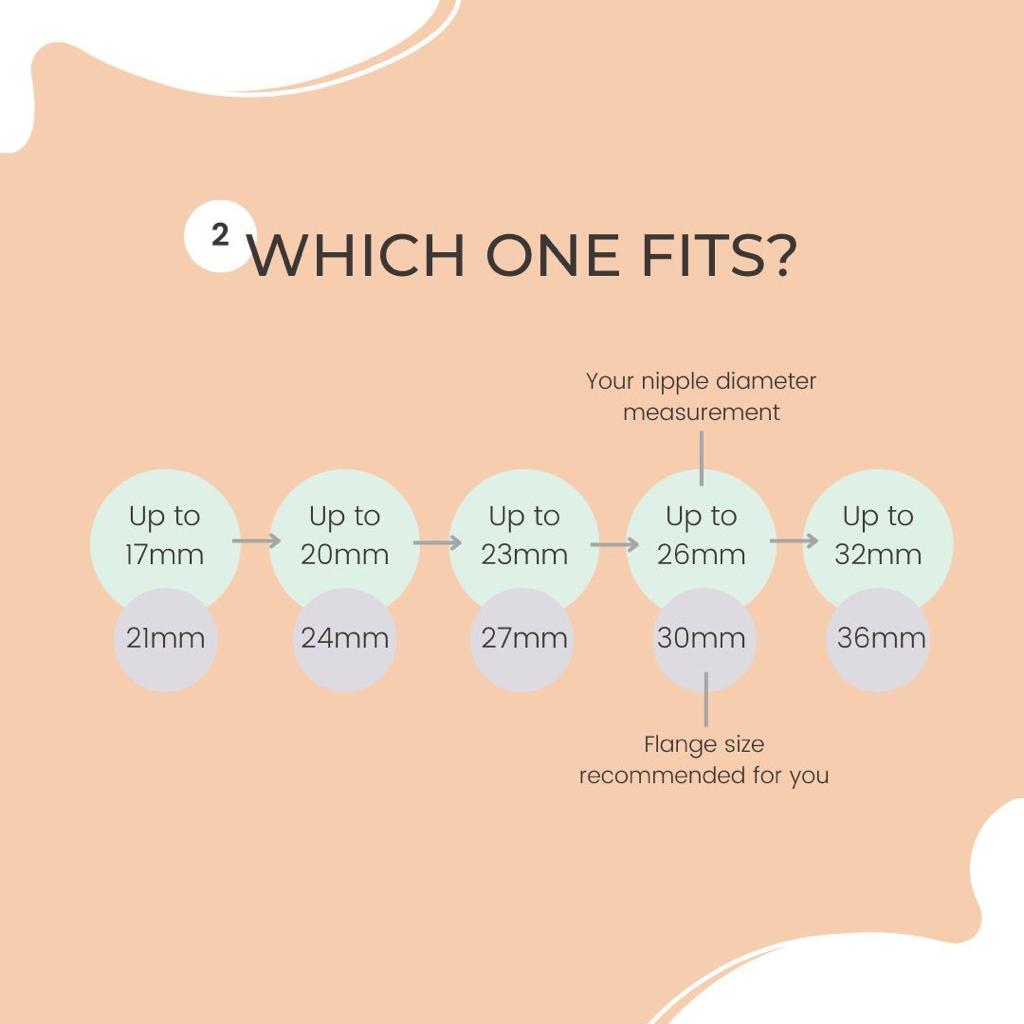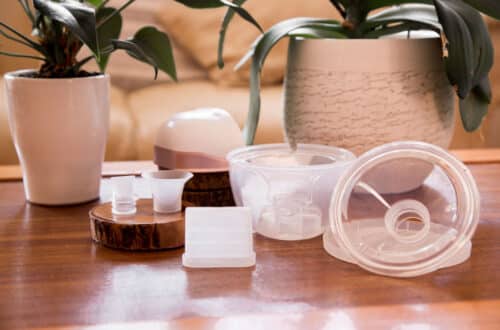
Wearable Breast Pump vs. Conventional Breast Pump: What to choose?
Breastfeeding is a beautiful and natural way for mothers to nourish their babies, but it can also present challenges, particularly when it comes to expressing breast milk. Thankfully, advances in technology have introduced a game-changer: wearable breast pumps. These innovative devices have transformed the breastfeeding experience, offering convenience, portability, and a new level of freedom for mothers.
What are Wearable Breast Pumps and what benefits do they have?
Wearable breast pumps are designed to be discreet, hands-free, and easily portable, making them a popular choice among modern mothers. Unlike conventional electric breast pumps, which typically consist of a motor unit connected to breast shields through tubing, wearable pumps are compact and worn directly on the breast. This eliminates the need for external tubes or motors, providing a hassle-free pumping experience.
Operating these pumps is a breeze. Once securely positioned on the breast, they use gentle suction to stimulate the flow of milk and collect it in attached containers or bags. Many models offer customizable settings, allowing mothers to adjust the suction strength and pumping patterns to suit their comfort and individual needs.
The benefits of wearable breast pumps over conventional electric pumps are substantial. Firstly, their compact and discreet design allows mothers to pump discreetly and without being tethered to a wall outlet. This freedom of movement enables multitasking and empowers mothers to continue with their daily activities while expressing milk. Whether it’s working, running errands, or caring for their little ones, wearable breast pumps integrate seamlessly into the busy lives of modern mothers.
Moreover, wearable pumps offer a hands-free pumping experience. By eliminating the need to hold breast shields manually, mothers can reclaim their hands for other tasks or simply relax during pumping sessions. This convenience is particularly advantageous for busy mothers juggling multiple responsibilities.
Another significant advantage is the reduced noise level of wearable breast pumps. Unlike their conventional counterparts, which can produce noticeable sounds during operation, wearable pumps prioritize discretion. The quiet operation ensures privacy and allows mothers to pump comfortably in public or professional settings without drawing unnecessary attention.
It’s worth noting that while wearable breast pumps may have fewer customizable options compared to conventional electric pumps, the latest models have made great strides in this area. Many now offer adjustable suction strength and pumping patterns, allowing mothers to find a setting that closely mimics a baby’s natural nursing rhythm.
The Advantages and Disadvantages of Wearable Breast Pumps
Wearable breast pumps have gained significant popularity among breastfeeding mothers due to their unique features and benefits. However, like any device, they come with both advantages and disadvantages. Let’s explore the pros and cons of using wearable breast pumps to help you make an informed decision.
Advantages:
- Convenience: The convenience factor is one of the most prominent advantages of wearable breast pumps. These pumps are designed to be compact and discreet, allowing mothers to wear them directly on the breast without the need for tubes or external motors. The hands-free operation enables multitasking and the freedom to continue with daily activities while expressing milk, making them ideal for busy moms.
- Portability: Wearable breast pumps are highly portable, offering the freedom to pump on the go. They are lightweight, compact, and easily fit into a bag or purse. This portability is especially beneficial for working mothers, travellers, or those who frequently find themselves outside the home. Pumping sessions can be discreetly carried out anywhere, whether it’s at the office, during a commute, or while running errands.
- Hands-Free Operation: The hands-free functionality of wearable breast pumps is a game-changer. By eliminating the need to hold breast shields manually, mothers have the flexibility to use their hands for other tasks or simply relax during pumping. This feature enhances comfort and convenience, allowing mothers to engage in activities such as reading, working on a computer, or even bonding with their baby.
- Discreet and Quiet: Wearable pumps prioritize discretion. They operate quietly, minimizing noise and drawing minimal attention during pumping sessions. This discreetness allows mothers to pump comfortably in public or work settings without feeling self-conscious or intrusive. It contributes to a sense of privacy and empowers mothers to express milk whenever and wherever needed.
- Customization options: Newer advanced wearable breast pump models offer the same customization options compared to more conventional electric breast pumps. This might be a consideration for mothers who require specific settings to mimic their baby’s nursing patterns. It’s best to ensure what features a wearable breast pump has before purchasing.
Disadvantages:
- Potential Lower Suction Strength: Due to their compact and wearable design, some wearable breast pumps may have slightly lower suction strength compared to larger electric pumps. While many wearable pumps still provide adequate milk expression for most breastfeeding mothers, those with specific needs or challenges in milk supply might require higher suction strength. Advanced design in some wearable breast pumps do however have a higher suction strength than models released a few years back.
- Higher Cost: Another factor to consider is the cost. Wearable breast pumps, being a newer technology, often come with a higher price tag compared to conventional electric pumps. This cost difference might be a consideration for budget-conscious mothers or those covered by insurance that may only offer coverage for traditional pumps. However, there are definitely cheaper options available when shopping around.
Wearable breast pumps offer remarkable convenience, portability, and hands-free operation, enabling mothers to integrate pumping seamlessly into their daily routines. However, it’s important to consider the potential limitations such as fewer customization options and the higher cost associated with these devices. By weighing the advantages and disadvantages, you can make an informed decision based on your specific needs and preferences.
Choosing the Right Wearable Breast Pump: Factors to Consider for a Perfect Fit
When selecting a wearable breast pump, several factors should be taken into consideration to ensure it meets your specific needs and provides a comfortable pumping experience. Here are some key factors to consider:
- Suction Strength: Check the suction strength offered by the wearable breast pump. It should be sufficient to stimulate milk flow and effectively express milk. Look for models that allow you to adjust the suction strength according to your comfort level and milk production needs.
- Comfort: Comfort is crucial during pumping sessions. Look for a wearable breast pump that comes with soft, flexible breast shields that fit your breast shape and size. A comfortable fit helps prevent discomfort or nipple pain, ensuring a pleasant pumping experience.
- Noise Level: Consider the noise level of the wearable breast pump. Look for pumps that operate quietly, as this allows for discreet pumping in public or work settings without drawing unnecessary attention.
- Battery Life: Evaluate the battery life of the wearable breast pump, especially if you intend to use it on the go or without access to a power source. A longer battery life ensures uninterrupted pumping sessions and eliminates the need for frequent recharging.
- Ease of Cleaning: Check how easy it is to clean the wearable breast pump. Look for pumps with detachable components that are easy to disassemble and clean thoroughly. Dishwasher-safe parts or pumps with fewer small, intricate pieces can simplify the cleaning process.
- Compatibility with Different Breast Sizes: Ensure that the wearable breast pump is compatible with a range of breast sizes. Some pumps offer multiple breast shield sizes or provide options for adjusting the fit, ensuring a comfortable and effective pumping experience for various breast shapes and sizes. Follow this guide to ensure you choose the right flange for your breast size:


- Portability and Discretion: Consider the portability of the wearable breast pump. Look for compact, lightweight designs that can be easily carried in a bag or worn discreetly under clothing. This allows you to pump on the go and maintain privacy in public settings.
- User-Friendly Features: Explore additional features and functionalities that enhance usability. This may include intuitive controls, LCD screens, timer functions, and memory settings to remember preferred pumping patterns.
- Reviews and Recommendations: Research customer reviews and recommendations for different wearable breast pump models. Feedback from other breastfeeding mothers can provide valuable insights into the performance, reliability, and overall satisfaction with specific pumps.
Tips for Successful Pumping with a Wearable Breast Pump: Maximizing Comfort and Efficiency
Using a wearable breast pump can offer convenience and flexibility during your breastfeeding journey. To make the most of your pumping sessions, consider the following tips:
- Ensure Proper Fit and Positioning: Achieving a proper fit is essential for optimal comfort and milk expression. Follow the manufacturer’s instructions for fitting the breast shields correctly. The shields should fit snugly around the nipple, creating a seal without causing discomfort or constriction. Adjust the straps or settings as needed to ensure a secure and comfortable fit.
- Find a Relaxing Environment: Create a calm and comfortable environment before starting a pumping session. Find a quiet space where you can relax and focus on expressing milk. Consider using relaxing techniques such as deep breathing, listening to soothing music, or visualizing your baby to help stimulate milk flow.
- Manage Milk Supply: If you’re using a wearable breast pump as your primary method of milk expression, it’s important to establish and maintain a healthy milk supply. Pump regularly and consistently, aiming for at least 8 to 10 pumping sessions per day, spaced evenly throughout the day. Consider pumping for about 15 to 20 minutes per session, or until your breasts feel empty. This regular stimulation helps maintain milk production and supply.
- Optimize Pumping Sessions: Experiment with different suction levels and pumping patterns to find what works best for you. Start with a gentle suction setting and gradually increase if needed. Some pumps offer various modes, such as massage or let-down modes, to stimulate milk flow before switching to a more efficient pumping mode. Take breaks if necessary during longer pumping sessions to rest and reposition the pump for maximum comfort.
- Maintain Hygiene: Cleanliness is crucial when using a wearable breast pump. Follow the manufacturer’s instructions for cleaning and sterilizing the pump components, such as breast shields, valves, and collection containers. Wash your hands thoroughly before handling the pump or expressing milk to minimize the risk of contamination. Proper hygiene practices help ensure the safety and quality of the expressed milk.
- Stay Hydrated and Well-Nourished: Drink plenty of fluids and maintain a balanced diet to support milk production. Stay hydrated by drinking water throughout the day. Consider having a healthy snack or meal before or after pumping sessions to replenish your energy levels.
- Utilize Hands-Free Pumping Accessories: Invest in hands-free pumping accessories, such as nursing bras, to further enhance your pumping experience. These accessories securely hold the pump in place, allowing you to use your hands for other activities or simply relax.
- Seek Support and Guidance: If you have any concerns or questions about using a wearable breast pump, reach out to a lactation consultant, breastfeeding support group, or your healthcare provider. They can provide personalized guidance and address any specific challenges you may encounter.
Remember, each mother’s pumping journey is unique, and it may take some trial and error to find the routine and settings that work best for you. Stay patient, be kind to yourself, and celebrate every ounce of milk you’re able to provide for your baby.
Tips for Pumping on the Go: Discreet and Comfortable Breast Milk Expression Anywhere
Pumping breast milk on the go can be a practical solution for breastfeeding mothers who are returning to work, traveling, or need to pump in public spaces. Here are some tips to help you pump discreetly and comfortably while managing logistical challenges:
- Plan Ahead: Plan your pumping schedule and identify suitable locations in advance. Take into consideration your work or travel itinerary, and determine when and where you can fit in pumping sessions. If you’ll be away from home for an extended period, research breastfeeding-friendly spaces such as lactation rooms, nursing lounges, or private areas at your destination.
- Use a Pumping Bag: Purchase a dedicated pumping bag to keep all your pumping essentials organized and easily accessible. Look for bags with insulated compartments to store expressed milk, along with compartments for pump parts, storage bags, and cleaning supplies.
- Dress Strategically: Choose clothing that allows easy access to your breasts for pumping. Opt for loose-fitting tops, button-down shirts, or clothing with discreet openings that provide convenient and discreet access for pumping. Consider wearing a pumping bra or bustier for hands-free pumping, which allows you to pump discreetly while keeping your hands free.
- Utilize Privacy Options: If pumping in a public space, look for privacy options such as nursing rooms, private offices, or designated areas for breastfeeding mothers. Many workplaces and airports provide these facilities. If privacy is limited, consider using a nursing cover or a lightweight scarf to provide some discretion while pumping.
- Communicate and Educate: If you’re pumping in a work setting, communicate with your employer or supervisor in advance about your pumping needs. Share information about your pumping schedule and discuss suitable accommodations for expressing milk. Educate your colleagues or travel companions about your pumping requirements to foster a supportive and understanding environment.
- Storage and Transport: Carry clean, sterilized breast milk storage containers or bags with you for storing expressed milk. Portable cooler bags with ice packs can help maintain the freshness of the milk while on the go. Ensure the containers are properly labelled with the date and time of expression.
- Be Mindful of Hygiene: When pumping in various settings, prioritize hygiene. Wash your hands thoroughly before handling the pump or expressing milk. If cleaning facilities are limited, carry extra pump parts or use disposable pump parts to minimize the need for cleaning on the go. Pack sanitizing wipes or a small bottle of hand sanitizer for cleaning surfaces or pump parts when necessary.
- Stay Hydrated and Relaxed: Again, staying well-hydrated by drinking water regularly to support milk production is of the utmost importance for a successful breastfeeding journey. Find ways to relax and stay calm during pumping sessions, such as deep breathing, listening to soothing music, or looking at a picture of your baby. Relaxation can enhance milk flow and make pumping more comfortable.
Remember, each pumping experience may present unique challenges, but with proper planning, organization, and a positive mindset, you can pump on the go successfully while maintaining your breastfeeding goals.
Care and Maintenance of Wearable Breast Pumps: Keeping Your Pump Clean and Functioning Well
Proper care and maintenance of your wearable breast pump are essential for its longevity, hygiene, and optimal performance. Head to our blog page for a detailed guideline on how to keep your breast pump clean.
Breast Pumping and Milk Supply: Maintaining and Increasing Milk Production with a Wearable Breast Pump
Breast pumping plays a crucial role in maintaining and increasing milk supply for breastfeeding mothers. If you’re using a wearable breast pump, here are some tips to help you effectively maintain and potentially increase your milk production:
- Establish a Pumping Routine: Set a consistent pumping schedule that mimics your baby’s feeding patterns. Aim for pumping sessions every 2-3 hours, even during the night if possible. Regular and frequent stimulation of the breasts helps maintain milk production.
- Empty the Breasts Fully: Ensure that you empty your breasts fully during each pumping session. Emptying the breasts signals your body to produce more milk. Consider pumping for at least 15-20 minutes per session or until your breasts feel soft and empty.
- Utilize Hands-On Pumping Techniques: While using a wearable breast pump, you can incorporate hands-on pumping techniques to further stimulate milk flow. Massage your breasts before and during pumping sessions by gently applying pressure from the base of the breast toward the nipple. This can help increase milk yield and promote efficient milk removal.
- Optimize Pumping Settings: Experiment with the suction strength and pumping settings on your wearable breast pump. Find the settings that are most comfortable and effective for you. Many pumps offer different modes, such as a let-down mode or adjustable suction levels, which can help initiate milk flow and maximize milk expression.
- Double Pumping: Consider double pumping, using a wearable breast pump that allows you to express milk from both breasts simultaneously. Double pumping can save time and has been shown to stimulate higher levels of prolactin, the hormone responsible for milk production.
- Maintain a Healthy Lifestyle: Proper self-care, hydration, and nutrition are vital for maintaining and increasing milk supply. Stay well-hydrated by drinking plenty of water throughout the day. Consume a well-balanced diet rich in nutritious foods, including fruits, vegetables, whole grains, and lean proteins. Some breastfeeding mothers find that certain lactation-friendly foods, such as oats or brewers yeast, may help support milk production, although individual results may vary.
- Take Care of Yourself: Managing stress levels and getting enough rest are important factors in maintaining milk supply. Reduce stress through relaxation techniques such as deep breathing, meditation, or gentle exercise. Adequate sleep and self-care can positively impact your milk production.
Wearable breast pumps have emerged as a revolutionary solution for breastfeeding mothers, providing convenience, portability, and hands-free operation. They offer a level of freedom and flexibility that conventional electric pumps simply cannot match. With these devices, mothers can express milk comfortably, discreetly, and efficiently, enabling them to navigate their breastfeeding journey with greater ease.



